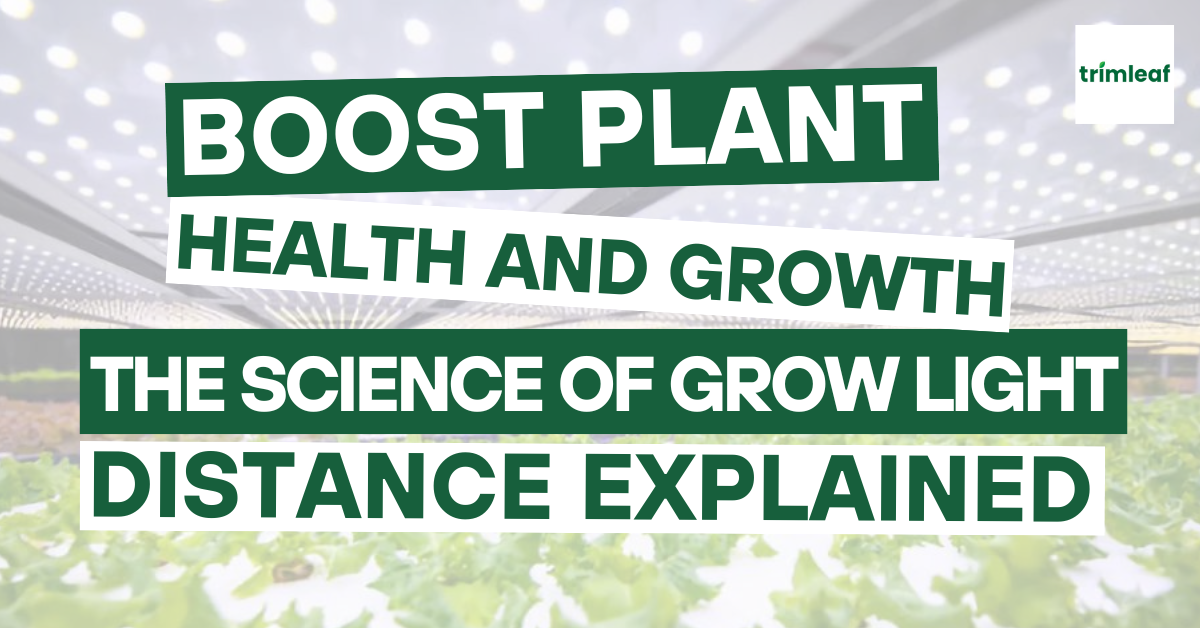
As indoor gardening becomes increasingly popular, the role of grow lights in supporting healthy plant development is more important than ever.
LED grow lights and full-spectrum LED lights, in particular, have revolutionized indoor gardening with their energy efficiency, long lifespan, and ability to provide full-spectrum lighting that mimics natural sunlight. These advantages help nurture plants at every stage of growth.
However, the effectiveness of LED grow lights depends heavily on one critical factor: their distance from the plant canopy. Miscalculating this distance can lead to poor growth, reduced yields, and even plant damage.
Table of Contents
Why Grow Light Distance Matters

The distance between your grow lights and the plant canopy is crucial for plant health and growth. This is because light intensity diminishes rapidly with distance due to the inverse-square law, which states that light intensity decreases exponentially as you move away from the source.
For example, if you double the distance between the grow light and your plants, the light intensity is reduced to just one-quarter of its original value. Mismanaging this distance can cause two major problems:
- Light burn: This occurs when grow lights are too close to the plant canopy, causing leaves to become scorched, turn yellow, or brown.
- Light stretch: When lights are too far away, plants grow tall and spindly as they stretch toward the light, resulting in weak stems and sparse foliage.
Different plants and growth stages require varying light intensities:
- Seedlings thrive under lower light intensity and need lights placed further away.
- Vegetative and flowering plants need more intense light for strong, bushy growth and blooming.
Methods for Measuring Light Intensity

Accurately measuring light intensity is key to optimizing the distance between your LED grow lights and the plant canopy. Here are three common methods:
- PAR Meters: The gold standard for measuring light intensity, PAR meters provide precise readings in PPFD (Photosynthetic Photon Flux Density), allowing you to calculate the ideal distance based on your grow light’s output.
- Smartphone Apps: While not as accurate as PAR meters, some apps, such as Photone, can measure light intensity using your phone’s camera sensor. These are useful for hobby growers looking for an affordable solution.
- Manual Estimation: Manufacturers often provide guidelines, making it easier to estimate the optimal distance for different growth stages.
Intensity is critical to note, since you want your plants to receive the right amount of light, given a certain distance.
How to Calculate the Ideal Distance for Each Growth Stage
Plants require different light intensities at various stages of growth. Use this table as a guideline for setting the ideal distance between your grow lights and the plant canopy:
|
Plant Growth Stage |
Ideal PPFD (µmol/m²/s) |
Canopy Distance |
|
Seedling Stage |
200-400 |
45-60 cm (18-24 inches) |
|
Vegetative Stage |
400-600 |
30-45 cm (12-18 inches) |
|
Flowering Stage |
600-900 |
30-45 cm (12-18 inches) |
These values are derived from the inverse-square law, which helps determine how light intensity diminishes with distance. The formula for calculating the ideal distance is:
Where:
- D is the distance between the canopy and the grow light.
- P is the total PPFD output of the grow light.
- I is the desired PPFD for a specific growth stage.
If space is limited, such as in a small grow tent, you can adjust the light intensity instead of distance by using this formula:
This allows you to tweak light intensity based on the available space, ensuring your plants still receive the optimal light. If intensity cannot be adjusted, you may want to look into using controllers to help you adjust the brightness.
Common Mistakes to Avoid with Grow Light Distance
Setting the correct distance between grow lights and the plant canopy is vital for plant health, but common mistakes can compromise your plants' development. Avoid these pitfalls:
Placing Lights Too Close
When grow lights are positioned too close to the canopy, light burn can occur. Common signs of light burn include:
- Leaf discoloration - Leaves turning yellow or brown, particularly at the top.
- Curling - Leaves may curl upwards or develop crispy edges.
- Stunted growth - Plant energy is diverted into healing instead of growing.
Use the manufacturer’s recommended mounting height and regularly monitor your plants to prevent light burn.
Placing Lights Too Far
Placing lights too far from the canopy leads to light stretch, causing plants to grow tall and weak. Symptoms of light stretch include:
- Elongated stems - Plants grow tall and thin, often collapsing under their own weight.
- Sparse foliage - Fewer leaves lead to reduced photosynthesis and slower growth.
- Slower development - Plants prioritize reaching light over flowering or healthy growth.
Lower the lights slightly if you notice excessive stretching to encourage more compact, bushy growth.
Conclusion
Optimizing the distance between your grow lights and plant canopy is crucial for maintaining healthy plants, maximizing yields, and promoting energy efficiency. As your plants grow, regularly monitoring and adjusting light distance ensures they receive the right amount of light at each stage of development.
For those looking to upgrade or purchase new grow lights, explore our selection of high-quality LED grow lights designed to meet the needs of any indoor garden. For more tips and detailed advice, check out these helpful resources:
- LED Grow Lights: A Comprehensive Buyer's Guide
- The Best 4x4 LED Grow Lights
- Best LED Grow Lights (2024)
- Growing Indoors with LED Grow Lights? Here are 4 Things to Consider
- Grow Lights: How Many Watts Per Plant/Square Foot is Needed?
- LED Grow Lights and Eye Safety: What You Need to Know
- Pay Attention to These Things When Buying LED Grow Lights
Frequently Asked Questions About Grow Light Distance
- What are the signs of light stretch?
- Elongated stems, sparse foliage, and slower development.
- How can light burn be prevented?
- Follow the manufacturer's recommended mounting height and monitor plants regularly.
- Can smartphone apps be used to measure light intensity?
- Yes, but they are generally less accurate than PAR meters.
- What is the inverse-square law, and how does it relate to grow light distance?
- The inverse-square law states that light intensity decreases exponentially with distance.
- How can grow light distance be optimized for plants with different light requirements?
- Research the specific light needs of the plant species and adjust the distance accordingly.
- What factors determine the ideal distance between grow lights and plants?
- The plant's growth stage and the desired PPFD.
- What are the two main problems caused by incorrect grow light distance?
- Light burn and light stretch.
- How can the inverse-square law be used to calculate the ideal distance?
- The formula D = √(P / I) can be used, where D is distance, P is PPFD output, and I is desired PPFD.
- What is the most common mistake made with grow light distance?
- Placing the lights too close to the plants.
- Can the distance between grow lights be adjusted throughout the plant's life cycle?
- Yes, as plants grow and their needs change, the distance may need to be adjusted.




